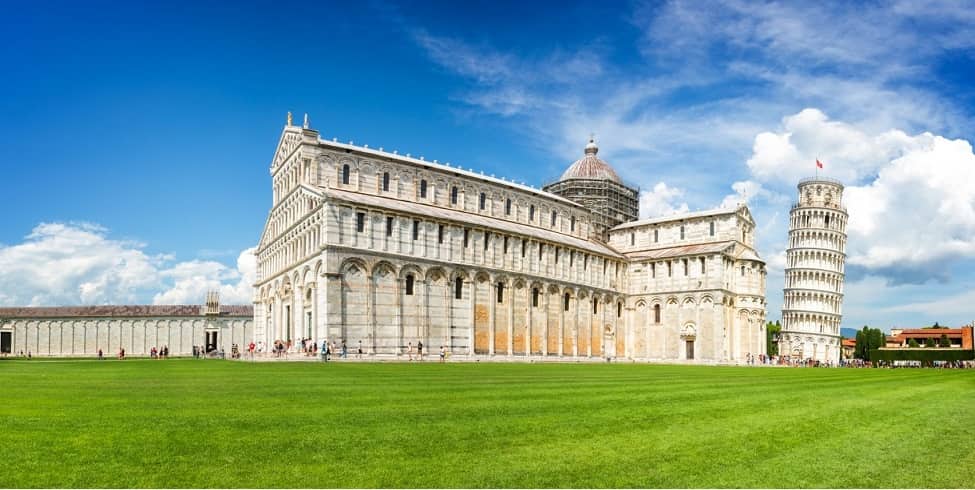A Site of Exceptional Universal Value
Pisa rises on the east coast of Tuscany, just over 80 km from Florence and easily accessible by car, train or bus. The birthplace of Galileo Galilei was one of the four Italian maritime republics in medieval times. It is rich in history, culture and art.
Piazza del Duomo in Pisa stands just on the edge of the urban agglomeration. It is a large square that hosts a group of architectural buildings of great artistic influence in Italy. These monuments represent a decisive stage in the history of medieval architecture and - as we will see - have also become a point of reference for the unprecedented "Pisan Romanesque" style, so named in honour of the city.
For this and other reasons, Piazza del Duomo in Pisa was included in the list of UNESCO sites in 1987 as a World Heritage Site of Exceptional Universal Value.
Here are some of the criteria:
«Criterion (i): Artistically unique because of its spatial design, the Piazza del Duomo contains four absolute architectural masterpieces: the cathedral, the baptistery, the bell tower and the Campo Santo. Within these monuments are such world-renowned art treasures as the bronze doors and mosaics of the cathedral, the pulpits in the baptistery and cathedral, the frescoes of the Campo Santo, and many others».
«Criterion (vi): It was at the Cathedral of Pisa that Galileo Galilei (1564-1642), observing the oscillations of the bronze chandelier created by Battista Lorenzi, discovered at the age of 19 the theory of isochronism of small oscillations, a prelude to his pioneering work on dynamics. From the top of the campanile, he conducted experiments, which led him to formulate the laws governing falling bodies. Two of the principal buildings of the Piazza dei Miracoli are thus directly and tangibly associated with a decisive stage in the history of physical sciences».
Authenticity
«The monumental complex of the Piazza del Duomo of Pisa has retained over time the historical and artistic qualities and attributes that convey its Outstanding Universal Value. After the construction of the monumental buildings and of the square, the numerous interventions have strengthened the relationship between the square and the city, while respecting the values and significance of the buildings of the monumental complex. [...] The authenticity of the property, particularly in terms of location and setting, and form and design has been maintained over time».
Protection and management requirements
«A very ancient institution, the Opera Primaziale Pisana, supervises the management system. The Opera was set up in 1063 and is run by a Deputation (similar to a Board of Directors) which is composed of several members coming from the Diocesan Ordinary and Ministry of Internal Affairs. The management structure is legally constituted and pursues exclusively social solidarity purposes, [...] such as Care, protection, preservation and maintenance, promotion of the image and development of the site».

Prato dei Miracoli - The meadow of Miracles

Piazza del Duomo in Pisa is also known as Piazza dei Miracoli. This name derives from the original definition that the writer Gabriele D'Annunzio gave to the esplanade in his novel Forse che sì, forse che no (1910).
«L’Ardea roteò nel cielo di Cristo, sul prato dei Miracoli». (Ardea twirled in the heaven of Christ, on the meadow of miracles)
The decadent poet defines the monumental complex in the square as Prato dei Miracoli. It represents the places where the aforementioned miracles - the main moments of men religious life - are celebrated. The baptistery represents the beginning of religious life, the religious activity of the community takes place in the Cathedral, and, finally, the Campo Santo (cemetery) represents the last stage of earthly life.
The square and its monumental complex were not erected in the city centre but just outside the city walls. Presumably, this choice could represent the strength of the fearless Maritime Republic of Pisa that did not need to protect itself within the city walls. Indeed, the Middle Age represented its golden period, when the Republic asserted its supremacy internationally, to the point of claiming for itself the role of new Rome.
Piazza del Duomo - or Piazza dei Miracoli, as one may prefer - today is a vast expanse of meadow whose intense green acts as a lively chromatic contrast with the white marble of the four monuments. Originally, the monumental complex was designed as a whole. It wanted to represent the indissoluble bond between earthly and heavenly life - as D'Annunzio pointed out - and the path of man from the former to the latter.
The Baptistery

The Baptistery standing in front of the Cathedral represents the first step of earthly life towards the celestial one. The mammoth work is the largest baptistery ever built in Italy and - according to someone - in the world. It measures over 100 meters in diameter and more than 50 meters in height.
The imposing cylindrical monument dating back to the mid-12th century, is dedicated to Saint John the Baptist. It was built in Romanesque style by the architect Diotislavi. However, two hundred years later, the Baptistery was revisited by Nicola Pisano and his father Giovanni. They added gothic elements, a loggia and a dome. The Baptistery represents a harmonious yet daring fusion of elements of classical, Romanesque and Gothic style.
The internal spaces preserve works of art of exceptional artistic impact. In the centre of the Baptistery, the sculptor Guido di Bonagiunta Bigarelli created the baptismal font with an octagonal shape and decorated it with classical motifs. Before the dome was constructed, the source was illuminated by the natural light that entered from above. The effect had to be striking. Next to the presbytery, the pulpit built by the sculptor Nicola Pisano locates. With a hexagonal base and supported by seven Corinthian columns, the work is adorned with bas-reliefs depicting the main phases of Christ’s life: the Annunciation and the Nativity, the Adoration of the Magi, the Crucifixion and the Last Judgment.
Here is a fun fact: thanks to its particular structure, the baptistery has exceptional acoustics. You can enjoy a unique echo inside of it!
The Cathedral

The Cathedral's works began in 1063 by the architect Buscheto di Giovanni Giudice. On his tomb, the artist wanted an engraving to remember over time the exceptional work that took shape in his hands:
«Non ha uguali il tempio in marmo bianco come la neve». (The snow-white marble temple has no competitors)
The idea of the project was to match the mammoth Roman works, to emphasize the power of the Maritime Republic of Pisa as the other Rome. Not surprisingly, materials from monuments of the Roman age were inserted on the Cathedral sides.
The Cathedral dedicated to St. Maria Assunta locates in the centre of the square. It is composed of five naves surmounted by a dome. Inside the church, a striking meeting of different styles and cultures takes shape. Classical, Byzantine and Arab components perfectly coexist, demonstrating the richness and importance the city had reached as a Maritime Republic during the Middle Ages.
The typical polychrome architecture blends in harmonious contrast with the immaculate white of both the interior and exterior spaces. The unprecedented and original structure gave way to a new artistic style defined as Pisan Romanesque in honour of the city.
Here are two of the must-see artworks in the church:
-the spectacular apsidal Mosaic by the painter Cimabue, representing the Throne of Christ;
-the enchanting Pulpit by the sculptor Giovanni Pisano. He was able to conceive the structure as a narrative continuum thanks to the meticulousness he dedicated to the poses and gestures of the characters depicting the various phases of the life of Christ.
Both works are from the early 14th century.
The Leaning Tower

The bell tower of the Cathedral is worldwide known as the Leaning Tower. It is one of the most famous monuments in the world and an iconic symbol of Italy. In the initial project dating back to the 12th century, the tower was already designed as separated from the Cathedral.
The unusual and curious inclination is due to a subsidence of the land already present during the earliest construction phases. Today, millions of tourists visit the city every year to take the characteristic photo that, thanks to a studied perspective, portrays them while holding the sloping tower.
The work is 55 meters in height. Each floor has galleries and arcades, except for the last one that houses seven bells, one for each musical note. For many years, the bell tower remained closed to the public due to delicate maintenance works. However, if one dare climbs the nearly 300 steps, the view is breathtaking. From the top of the tower, it is possible to enjoy a unique panoramic view of Pisa.
Here is a fun fact: each bell has its name and plays its musical note! For example, the largest bell is called Assunta and plays a B, while the minor is called Vespruccio and plays an E. In the past, every bell rang at a precise moment of the liturgical day. Today, all the bells ring before Holy Mass and at noon.
Campo Santo - the cemetery

In the northern area of Piazza del Duomo, the monumental cemetery know as Campo Santo locates (in Italian, camposanto means graveyard). Founded in the second half of the 13th century by the architect Giovanni di Simone, the cemetery was born from a purely practical need, namely to house the tombs of prominent citizens until then scattered around the Cathedral.
The structure has two entrance doors. The main entrance is decorated with an elegant Gothic tabernacle above the portal and leads to the interior space that looks like a cloister adorned with pointed arches.
Pisa never abandoned the ambitious project to become the new Rome. Next to precious evidence of the history of Pisa, the cemetery walls host Roman inscriptions. Moreover, the inner corridors house a collection of Roman-style sarcophagi of several prominent figures of Pisan history. Thus, Campo Santo represents a kind of Pantheon of the city.
A series of stunning frescoes that survived the bombing of 1944 are found in Campo Santo internal spaces. Thanks to a meticulous restoration, the evocative painting The triumph of death by the painter Buonamico Buffalmacco can be still admired today.
Finally, Campo Santo preserves the statue of Leonardo Fibonacci, the mathematician from Pisa who first introduced Arabic numeration in the West, and the lamp of Galileo, a source of inspiration for Galilei's theories on isochronism.
Here is a fun fact: the place where the cemetery rests its foundations makes the work a real sacred place. According to the traditional story, the Pisans returning from the Second Crusade in the Holy Land transported portions of land taken from Jerusalem and buried them right where the Campo Santo (=Holy Camp) stands today.
About the author
Written on 03/04/2021




Sabrina Fabozzi
Piazza del Duomo in Pisa houses an impressive architectural complex of great artistic and cultural value. Discover its fascinating medieval history and peculiarities!